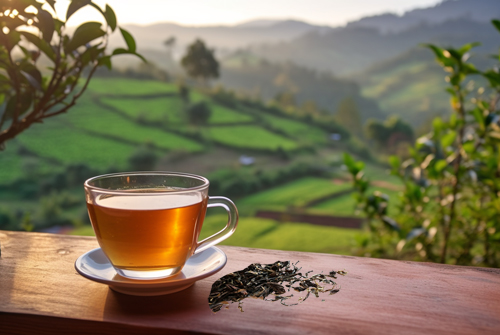Oriental Beauty Tea
Posted on Apr 19th 2023

Oriental Beauty Tea: The Champagne of Oolongs
In the world of oolong teas, Oriental Beauty stands out as a unique gem. This Taiwanese tea, with its compelling history and enchanting flavor profile, has charmed its way into the hearts of tea enthusiasts worldwide. Let's embark on a journey through the fragrant world of Oriental Beauty.
A Name Worthy of Its Beauty
Also known as "Dongfang Meiren" in Chinese and "Bai Hao Oolong" due to its characteristic white-tipped leaves, the name "Oriental Beauty" allegedly originates from a British tea merchant who, upon tasting it, believed it was so exquisite that even the Queen of England would find it beautiful.
A Serendipitous Discovery
The unique flavor of Oriental Beauty is credited to a tiny insect, the leafhopper. When these insects nibble on the tea leaves, the plant reacts by producing special compounds. This natural defense mechanism results in the tea's unique fruity and honeyed notes.
A Dance of Flavors and Aromas
Oriental Beauty is a sensory experience:
- Appearance: The leaves of Oriental Beauty are multicolored, ranging from silver to green to reddish-brown, indicating the rich complexity within.
- Aroma: The tea exudes a captivating scent of ripe fruits, honey, and blossoms.
- Taste: A harmonious blend of sweetness, fruitiness, and a slight astringency makes each sip a nuanced experience. Hints of peach, apple, and wild honey are often discerned.
Brewing the Perfect Cup
For an optimal tea experience:
- Water: Use fresh, pure water. Heat to just below boiling, around 85°C - 90°C (185°F - 194°F).
- Tea Quantity: Use about 5 grams of tea leaves for every 150 ml of water.
- Steeping: Allow the tea to steep for 3-5 minutes. Adjust the timing based on personal preferences.
- Multiple Infusions: Oriental Beauty can be steeped multiple times, with each infusion revealing a new facet of its complex flavor.
A Tea of Many Virtues
While Oriental Beauty is celebrated primarily for its taste, oolong teas are also known for their health benefits, ranging from boosting metabolism to aiding digestion and promoting skin health.
A Toast to Terroir
Like wines, teas also reflect their terroir. The specific climatic conditions and soil of the region where Oriental Beauty is cultivated contribute significantly to its distinct character.
Conclusion
Oriental Beauty tea is not just a beverage; it's a tale of nature, culture, and artistry. From the serendipitous interplay between leafhoppers and tea plants to its regal reception on international shores, every aspect of this tea adds to its allure.
To moments of beauty, serendipity, and the age-old charm of tea!
 Loading... Please wait...
Loading... Please wait...